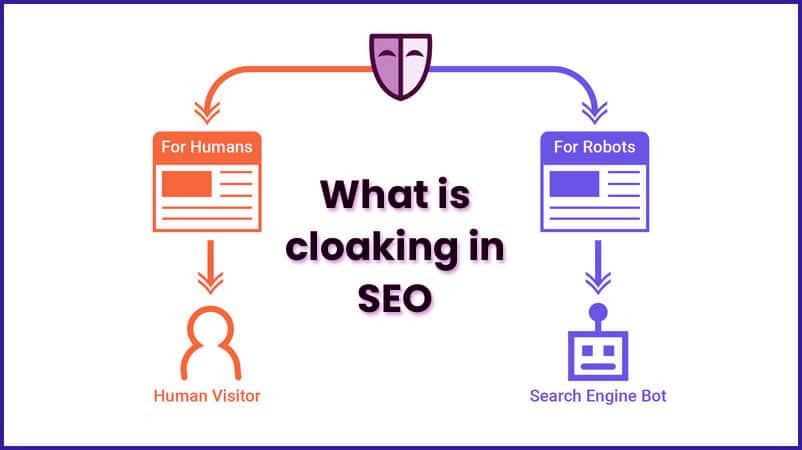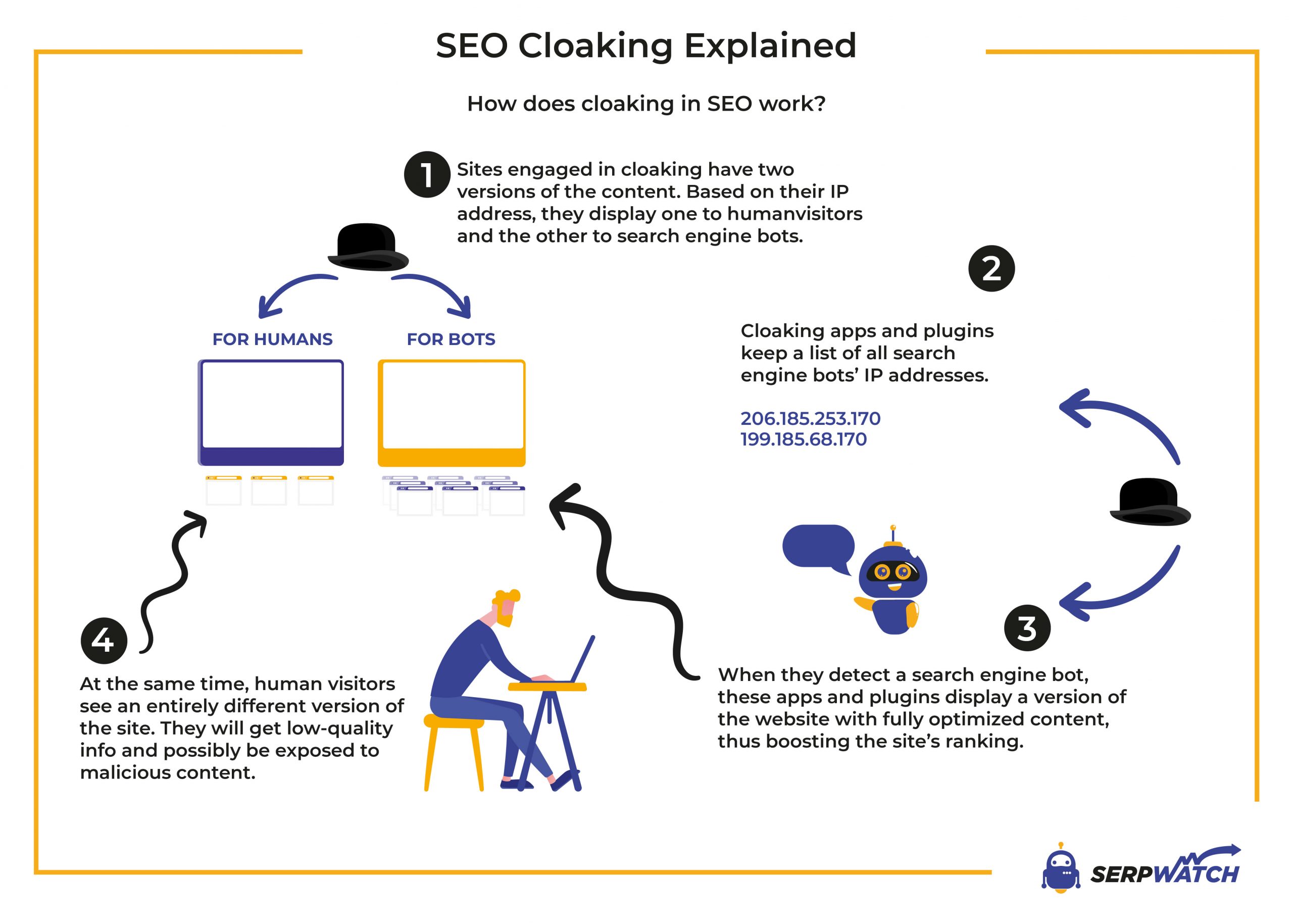Cloaking is a deceptive technique used in web design and search engine optimization (SEO) to deliver different content to users and search engine crawlers. It involves displaying one version of a website to search engines while showing a different version to human users. The primary motivation behind cloaking is to manipulate search engine rankings and achieve higher visibility in search results through deceptive means. However, this practice is considered a black hat SEO technique and is explicitly prohibited by major search engines like Google, Bing, and Yahoo.
Cloaking Techniques

There are several methods employed to implement cloaking, each with its own level of sophistication and deception. Here are some common cloaking techniques:
IP Delivery: IP delivery is one of the most basic forms of cloaking. In this method, the server checks the IP address of the incoming request and delivers different content based on whether the IP address belongs to a search engine crawler or a human user. Search engines often use specific IP ranges for their crawlers, making it relatively easy to identify and serve them a different version of the website.User-Agent Delivery
User-agent delivery: is another common cloaking technique that relies on the user-agent string sent by web browsers and crawlers. The server analyzes the user-agent string to determine if the request is coming from a search engine crawler or a human user. If it’s a crawler, the server serves an optimized version of the website designed to rank better in search results. If it’s a human user, the server delivers the actual website content.
JavaScript Cloaking: JavaScript cloaking is a more advanced form of cloaking that exploits the way search engine crawlers process JavaScript. In this technique, the website’s HTML code contains JavaScript that generates different content based on certain conditions, such as the user-agent string or the presence of specific browser capabilities. When a search engine crawler visits the website, it may render and index the content generated by the JavaScript, while human users see a different version of the website.

Redirect Cloaking: Redirect cloaking involves redirecting search engine crawlers to a different URL or IP address than the one served to human users. This technique can be implemented using server-side scripts or client-side code like JavaScript. The crawler is redirected to a version of the website optimized for search engines, while human users are shown the actual website content.
Doorway Page Cloaking is a specific form of cloaking that involves creating multiple pages on a website, each optimized for a different set of keywords or phrases. These doorway pages are designed to rank well in search results for their targeted keywords, but they provide little value to human users. When a user clicks on a doorway page from the search results, they are redirected to a different page on the website, often the homepage or a more relevant page.
Consequences of Cloaking

While cloaking may seem like an attractive way to improve search engine rankings, it comes with significant risks and consequences. Major search engines strictly prohibit cloaking and consider it a violation of their webmaster guidelines. If detected, websites engaged in cloaking can face severe penalties, including:
Manual Penalties
Search engines like Google employ teams of human reviewers who manually evaluate websites for compliance with their guidelines. If cloaking is detected, these reviewers can apply manual penalties to the website, which can result in a significant drop in search rankings or even complete removal from the search engine’s index.
Algorithmic Penalties
In addition to manual penalties, search engines have algorithms designed to detect and penalize cloaking and other deceptive techniques. These algorithmic penalties can automatically demote the rankings of websites engaged in cloaking, making it difficult for them to achieve visibility in search results.
Lack of Trust and Credibility
Cloaking is inherently deceptive, as it involves presenting different content to search engines and users. If detected, it can severely damage the trust and credibility of a website, both with search engines and human users. This can lead to long-term negative impacts on the website’s reputation and search performance.
Legal Consequences
In some jurisdictions, cloaking may be considered a form of false advertising or deceptive marketing practices, which can potentially lead to legal consequences and fines. It’s essential to consult with legal professionals to understand the implications of cloaking in your region.
Alternatives to Cloaking

Instead of resorting to cloaking, there are ethical and sustainable ways to improve a website’s search engine rankings and visibility:
High-Quality Content: Creating high-quality, relevant, and valuable content is one of the most effective ways to improve search engine rankings. Search engines prioritize websites that provide useful information to users, so focusing on creating high-quality content tailored to user needs is crucial.
On-Page Optimization: Optimizing individual web pages for relevant keywords and phrases can improve their visibility in search results. This includes optimizing page titles, meta descriptions, headings, and body content while ensuring a good user experience.
Technical SEO: Addressing technical SEO issues, such as site speed, mobile-friendliness, structured data, and site architecture, can significantly improve a website’s search engine rankings and user experience.
Link Building: Building high-quality backlinks from reputable and relevant websites is an important ranking factor for search engines. Engaging in ethical link-building practices, such as guest blogging, creating valuable resources, and building relationships with industry influencers, can improve a website’s authority and search visibility.
User Experience Optimization: Optimizing the user experience on a website can indirectly improve search engine rankings. Search engines prioritize websites that provide a good user experience, so focusing on elements like navigation, site design, and load times can positively impact search visibility.
Conclusion
Cloaking is a deceptive practice that involves serving different content to search engines and human users. While it may seem like a shortcut to improving search engine rankings, it violates the guidelines of major search engines and carries significant risks, including manual penalties, algorithmic penalties, and damage to a website’s trust and credibility.
Instead of relying on cloaking, website owners and SEO professionals should focus on creating high-quality content, optimizing on-page elements, addressing technical SEO issues, building high-quality backlinks, and providing an excellent user experience. These ethical and sustainable practices not only improve search engine rankings but also build trust and credibility with users, leading to long-term success in the online landscape.
Did you like this article? Do not hesitate to share it on social networks and subscribe to Tech To Geek on Google News to not miss any articles!“Because of the Google update, I, like many other blogs, lost a lot of traffic.”
Join the Newsletter
Please, subscribe to get our latest content by email.
